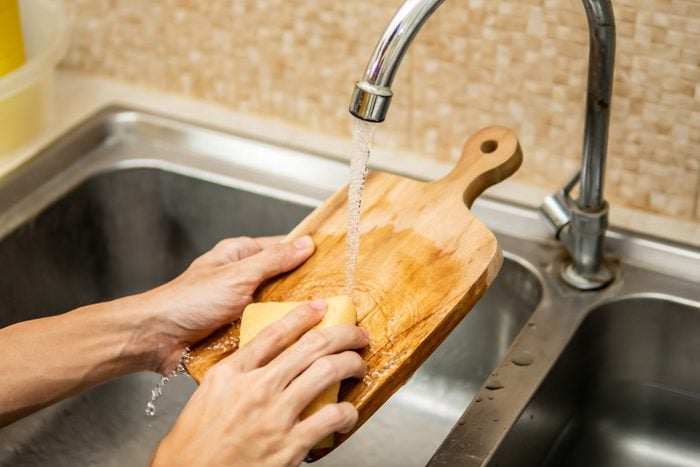How to Clean a Wooden Cutting Board
Updated: May 16, 2023

It's easier to clean a cutting board than you think—and super important for maintaining the longevity of your boards.
Wooden boards, apart from being the cutest way to serve charcuterie, are an essential kitchen tool. In order to maintain your wooden boards, though, it’s important to clean them properly. This will keep them in the best condition for slicing and dicing produce or for serving meats and cheeses.
First, we’ll go over how to clean a wooden cutting board, and then we’ll wrap up with how to maintain your wooden boards once they’ve been properly cleaned.
What You Need to Clean Your Wooden Cutting Board
- Dish soap and water
- Lemons and salt
- Vinegar
- Bleach
How to clean a wooden cutting board with soap and water
If your wooden cutting board is your favorite cutting board, then you probably use it for even the simplest things. Chopping veggies to go into a soup or slicing fruits to pop into a blender for a smoothie isn’t going to dirty your wooden board too much. Because this is the case, a simple wash with soap and water is just fine. Don’t use anything harsh like steel wool to scrub the soap into your board. A soapy cloth or sponge will do the trick.
How often to wash with soap and water: After every use.
How to clean a wooden cutting board with lemons and salt
There are so many things you can clean with lemons, and wooden boards are absolutely one of them. The best part about cleaning a wooden cutting board with lemons is that the citrus will clean and deodorize your board at the same time.
If you’ve recently chopped strongly smelling foods like garlic or Brussels sprouts, the smell of the food might linger in the crevices of the board. Sprinkle coarse kosher salt on your board, slice a lemon in half and rub it cut side down on the board. It’s best to scrub in small circular movements and go with the grain of the board. Once any food buildup is removed, you can rinse the board and let it air dry.
How often to wash with lemons and salt: A monthly cleanse with lemons and salt will remove stains and strong smells from your beautiful wooden board.
How to clean a wooden cutting board with vinegar
Vintage cleaning tips that still hold true today really come in handy. Grandma always had vinegar under the sink, and so should you. Cleaning with vinegar can help get built-up germs off your cutting board. While soap and water might be enough to clean a board you’ve just chopped veggies on, vinegar will be more useful in removing harmful bacteria from raw meats or fish.
If you’ve used your board to slice steak, salmon, pork or chicken recently, it’s time for a vinegar wash. You can dab vinegar onto a clean cloth and scrub your board, or you can put vinegar in a spray bottle for easy use. Simply spray the board, rub the vinegar into the board with a clean cloth and rinse.
How often to wash with vinegar: Spray or scrub your cutting board with vinegar once a week, rinse the vinegar off and let your board air dry.
How to clean a wooden cutting board with bleach
So soap and water didn’t work and lemons and vinegar didn’t cut it. It’s time to take your cutting board cleaning up a notch and refresh it with something stronger: bleach. Use bleach to clean your cutting board after chopping up raw meats or fish. This will prevent harmful bacteria from growing in the tiny cuts and crevices of the board.
Dilute 1 teaspoon of bleach with 2 quarts of water. Using a brush or a clean cloth, rub the solution into your cutting board in small circles. Don’t soak your board, but do use enough of the solution that you can cover the whole board. Wipe the wooden board with a clean, damp towel and then pat the board dry with a dry towel.
How often to wash with bleach: Similar to vinegar, you can use bleach on your wooden board after any raw meat has touched the surface, or once a week.
How to Oil Your Wooden Cutting Board
One final step that will keep your boards looking like they’re brand-new is oiling. A good time to oil your wooden cutting board would be after your monthly cleaning with lemons and salt. You don’t want to over-oil your board, so once every four weeks is a great schedule to follow.
It’s important to note that olive oil or canola oil won’t work for this step. For the safest and most effective results, use a food-grade mineral oil. Pour some of the oil onto a paper towel or clean cloth, and buff it into every inch of the cutting board. Let the oil soak in for an afternoon or overnight, then use a fresh cloth to wipe away any excess oil. The wood will be less prone to drying out and cracking, and the oil can help extend the life of your trusty boards.
